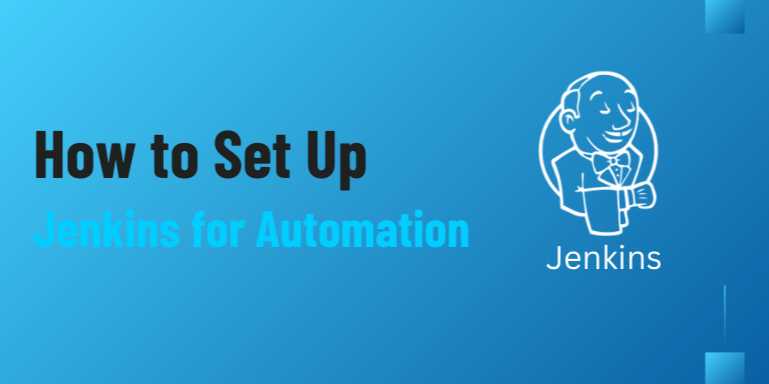How to Set Up Jenkins for Automation: A Complete Beginner’s Guide to CI/CD

📘 Chapter 1: Introduction to Jenkins and CI/CD
🔐 Introduction
Modern software development demands speed, precision, and
reliability. Teams can no longer afford long release cycles, manual testing, or
inconsistent environments. To address these challenges, DevOps practices —
especially Continuous Integration (CI) and Continuous Delivery (CD)
— have become essential. At the heart of these practices lies Jenkins,
the most widely used automation server in the DevOps ecosystem.
This chapter introduces you to Jenkins, explores its
role in automating CI/CD pipelines, and lays the foundation for setting up
Jenkins for real-world automation.
🚀 What is Jenkins?
Jenkins is an open-source automation server written
in Java. It enables developers and DevOps teams to build, test, and deploy
code automatically.
Originally developed as "Hudson" in 2004, Jenkins
became a standalone open-source project under the MIT license and is now one of
the most trusted CI/CD tools used by companies worldwide.
🎯 Core Features of
Jenkins
- CI/CD
pipeline automation
- Integration
with Git, Docker, Kubernetes, Maven, Gradle, and more
- Hundreds
of community-driven plugins
- Declarative
and scripted pipelines using Groovy
- Scalable
architecture with master-agent configuration
🔄 Jenkins in the DevOps
Toolchain
|
DevOps Stage |
How Jenkins Helps |
|
Plan |
Integrate with issue
trackers like Jira |
|
Code |
Monitor Git
commits and trigger builds |
|
Build |
Automate code
compilation and packaging |
|
Test |
Run unit,
integration, and regression tests |
|
Release |
Tag artifacts and
prepare for deployment |
|
Deploy |
Automate delivery
to staging or production |
|
Operate |
Trigger post-deploy
scripts and performance checks |
|
Monitor |
Send alerts
or logs via integrations |
🔁 CI/CD Concepts
Explained
✅ What is Continuous Integration
(CI)?
Continuous Integration is the practice of merging
all developer working copies to a shared mainline several times a day.
CI ensures:
- Early
detection of bugs
- Consistent
testing
- Faster
collaboration
✅ What is Continuous Delivery
(CD)?
Continuous Delivery automates the release process so
that code is always in a deployable state.
Key benefits:
- Faster
time-to-market
- Reduced
manual effort
- Lower
deployment risk
✅ CI/CD vs. Traditional
Development
|
Aspect |
Traditional Model |
CI/CD Model |
|
Build Frequency |
Infrequent, manual |
Frequent, automated
(every commit) |
|
Test Execution |
Delayed and
manual |
Early and
automated |
|
Deployment Process |
High risk, manual |
Low risk, automated |
|
Team Collaboration |
Siloed (Dev
vs Ops) |
Cross-functional
and collaborative |
🧠 Why Jenkins for CI/CD?
|
Reason |
Jenkins Advantage |
|
Open Source |
Free and widely
supported |
|
Plugin Ecosystem |
1800+ plugins
for integration with tools and platforms |
|
Customization |
Define workflows using
freestyle jobs or pipelines |
|
Extensibility |
Easily
integrate with Docker, Kubernetes, cloud providers |
|
Portability |
Run on Linux, Windows,
macOS, or inside containers |
🧩 Jenkins Architecture
Overview
Jenkins can be run on a single node or distributed across
multiple agents.
🌐 Components of Jenkins
Architecture:
|
Component |
Role |
|
Master (Controller) |
Schedules jobs,
handles UI, orchestrates builds |
|
Agent (Node) |
Executes jobs
(builds, tests, deploys) assigned by the master |
|
Job/Project |
Represents a task to
be executed (build, test, deploy) |
|
Executor |
A slot to run
a build on an agent |
|
Workspace |
Directory where
Jenkins executes job scripts |
Jenkins agents allow scaling horizontally — great for teams
with multiple simultaneous builds.
🧪 Jenkins Job Types
Jenkins supports multiple types of jobs. The two most
popular:
🛠️ Freestyle Project
- UI-based
configuration
- Ideal
for beginners and simple builds
🧾 Pipeline Job
- Defined
via Jenkinsfile (Groovy DSL)
- Best
for complex workflows with multiple stages
⚙️ Jenkins Workflow in CI/CD
- Developer
commits code to GitHub
- GitHub
webhook notifies Jenkins
- Jenkins
pulls the code and starts a job
- Jenkins
builds the application
- Tests
are executed automatically
- If
successful, artifacts are packaged
- Jenkins
deploys the app or triggers further stages
- Notifications
sent via email/Slack
🔧 Key Plugins to Know
Early On
|
Plugin |
Purpose |
|
Git Plugin |
Connects Jenkins to
GitHub, GitLab, Bitbucket |
|
Pipeline Plugin |
Enables
scripted and declarative pipelines |
|
Docker Pipeline |
Run CI/CD inside
Docker containers |
|
Slack Notifier |
Sends build
notifications to Slack channels |
|
Blue Ocean |
Modern UI for pipeline
visualization |
🏁 When to Use Jenkins (vs
Other Tools)
|
Use Jenkins
When... |
Consider
Alternatives When... |
|
You want full customization |
You want simplicity
and opinionated setup (e.g., GitHub Actions) |
|
You work with multiple languages/stacks |
You're deeply
integrated with one platform (e.g., GitLab) |
|
You want a
plugin-rich ecosystem |
You want minimal setup
or a SaaS-based tool |
|
You manage infrastructure and application code |
You need
managed CI/CD (e.g., CircleCI, Bitbucket Pipelines) |
📘 Summary
Jenkins is the cornerstone of many modern CI/CD pipelines.
Its open-source flexibility, vast plugin library, and scripting capabilities
make it the ideal choice for DevOps teams ready to automate their build, test,
and deployment processes.
With a basic understanding of CI/CD principles and
Jenkins architecture, you're now ready to dive deeper into installing
Jenkins, creating jobs, and building full pipelines — which we’ll cover in
the next chapters.
Jenkins isn’t just a tool — it’s the engine that powers
reliable, repeatable, and rapid software delivery.
FAQs
1. What is Jenkins and why is it used in automation?
Jenkins is an open-source automation server that helps developers automate building, testing, and deploying code. It enables Continuous Integration and Continuous Delivery (CI/CD), making software delivery faster and more reliable.
2. What are the system requirements to install Jenkins?
To install Jenkins, you need:
- Java
11 or later (Java 17 recommended)
- At
least 2 GB of RAM and 1 GB of disk space
- A
modern browser for accessing the Jenkins UI
3. What’s the easiest way to install Jenkins for beginners?
The simplest way is to use the Jenkins WAR file:
java -jar jenkins.war
Alternatively, you can use a Docker container for a quick and clean setup:
docker
run -p 8080:8080 jenkins/jenkins:lts
4. How do I connect Jenkins to my GitHub repository?
Install the Git and GitHub plugins, then:
- Create
a new job or pipeline
- Choose
“Git” as the source code management
- Enter
the GitHub repo URL and credentials if needed
- Add
a webhook to trigger Jenkins builds on each push
5. What is a Jenkins Pipeline?
A pipeline is a script-based workflow written in Groovy DSL that defines your automation steps (e.g., build, test, deploy). Pipelines can be declarative (simplified) or scripted (flexible).
6. What plugins should I install first in Jenkins?
For basic automation, start with:
- Git
plugin (source control)
- Pipeline
plugin (workflow scripting)
- Docker
plugin (if using containers)
- Blue
Ocean (modern UI for pipelines)
- Email
Extension (build notifications)
7. Can Jenkins be used with Docker and Kubernetes?
Yes! Jenkins integrates with Docker for building images and with Kubernetes for scaling jobs using agents. Tools like Jenkins X also help automate deployments in Kubernetes.
8. How do I secure my Jenkins installation?
- Use
HTTPS for the web UI
- Create
individual user accounts
- Configure
role-based access controls
- Mask
secrets and tokens in logs
- Regularly
update plugins and Jenkins core
9. How do I trigger Jenkins builds automatically?
You can:
- Use webhooks
from GitHub/GitLab
- Schedule
jobs using CRON syntax
- Trigger
builds after another job completes
- Use
a poll SCM trigger to check for changes periodically
10. Is Jenkins free to use for commercial projects?
Yes! Jenkins is 100% free and open-source, licensed under MIT. You can use it in personal, educational, and commercial environments without restriction.
Tutorials are for educational purposes only, with no guarantees of comprehensiveness or error-free content; TuteeHUB disclaims liability for outcomes from reliance on the materials, recommending verification with official sources for critical applications.
Explore Other Libraries
Please allow ads on our site
Kindly log in to use this feature. We’ll take you to the login page automatically.
Login
Join Our Community Today
Ready to take your education and career to the next level? Register today and join our growing community of learners and professionals.

Your experience on this site will be improved by allowing cookies. Read Cookie Policy
Your experience on this site will be improved by allowing cookies. Read Cookie Policy

Comments(0)